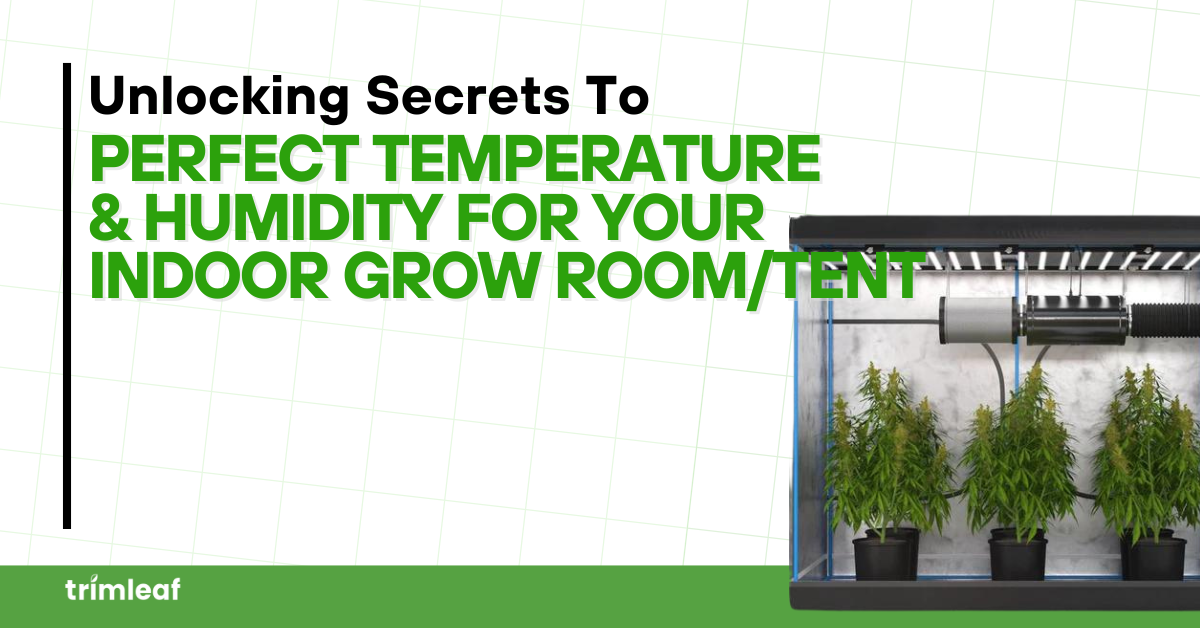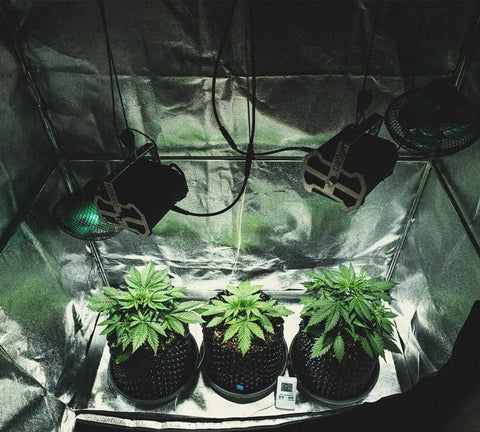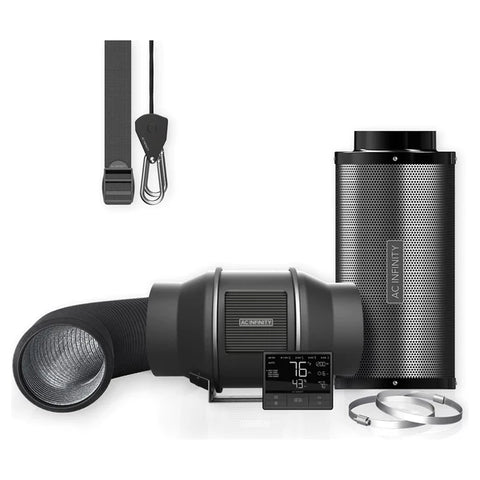
In recent years, there has been a notable surge in the popularity of indoor cultivation, drawing the interest of both beginner and seasoned horticulturists.

The shift towards cultivating plants indoors is driven by the desire for year-round cultivation, greater control over growing conditions, and the potential for higher-quality yields.
Meticulous environmental control within the grow room or tent is at the heart of successful indoor plant growth. Temperature and humidity are critical here; they can make or break any harvest.
Temperature stands out as a key player in plant growth, affecting various growth cycle stages. From the delicate germination of seeds to the flowering period, the temperature spectrum significantly impacts the plant's metabolic processes, ultimately dictating the overall health and yield.
Humidity also plays an equally crucial role. For plants to grow correctly, they need the right balance of moisture in the air that can prevent stress-induced issues and diseases that might compromise the well-being of cannabis plants.
It might be as simple as having fans or dehumidifiers inside the grow room, but some challenges must be addressed. Temperature and humidity tend to fluctuate, which can cause damage to your plants. In some cases, slight variances can cause stress to your plants and affect growth and yield.
Precision is the Key
Ensuring precision in measuring temperature and humidity is critical, as this lets you know the exact situation in the room. It would be best to have a hygrometer and thermometer to ensure you get the right results.
For those who don’t know, a hygrometer measures relative humidity in a room or grow tent, giving you an idea of how humid the area is and how much you need to pull in or out of the grow tent to get the ideal humidity levels.
To compliment your hygrometer, consider having a humidity chart handy. This tool gives you the humidity range needed for plant growth. To use this chart, you should identify the plant stage, then use the chart to look up the ideal humidity range. You should then make the necessary adjustments, as you monitor room conditions.
A thermometer is also essential to get an overall heat reading of the room or tent and adjust as needed.
To get the best results, you need to optimize the placement of these tools. Often, garden-grade thermometers and hygrometers have sensors you can place inside to sense the situation in the room or tent. The hygrometer is best placed at canopy level without any direct contact with the grow lights or walls that may affect the readings you get. For your thermometer, put it in a central location in the grow space while avoiding direct lights and airflow for an accurate reading.
It’s essential to have climate monitoring tools, as the overall conditions make a harvest successful. For one, you get to detect problems before they worsen so that you can make timely interventions. With real-time data, you can easily fine-tune the climate to make your plants comfortable.
Employing precision cultivation through these tools can also improve plant health and yield. And remember, each plant has specific temperature and humidity requirements, which is why climate precision is critical.
Setting the Environment for Your Plants
Each phase in the growth cycle entails attention to the environment to create the ideal conditions for robust growth and fruitful yields.
In the seedling stage, humidity, and temperature are critical as this step is crucial in developing your cultivations. During this phase, maintain a temperature range from 68 – 77 degrees Fahrenheit while decreasing it by nine degrees when the lights are out. For humidity, you need a relative humidity between 65 – 70 percent to promote water absorption in the leaves while roots develop.
Humidity and temperature are critical in root development and foliage growth for the vegetation stage. In this phase, decrease the relative humidity each week by five percent and maintain it within the 40 – 70 percent range. Aim for 71 – 82 degrees Fahrenheit for temperature when the lights are on and decrease it slightly when the lights are out.
The flowering stage is the penultimate phase before harvests, making it critical for environmental control. Maintain a relative humidity between 40 – 50 percent, and ensure you do not reach 60 percent, which can cause issues. Maintain temperature between 68 – 79 degrees Fahrenheit, preventing excess heat from accumulating.
In the final phases, you must fine-tune the environment for the best result. Lower the relative humidity to 30 – 40 percent for better yields, flavor, and appearance. For the temperature, lower it when simulating daytime, and increase it a little during night time.
Ensuring Temperature Control
Temperature can be hard to control independently, as grow lights can contribute to the heat. While you can employ fans, you might need more. That is why looking at other means to regulate temperatures inside the grow tent or room is critical.
To start, efficient air circulation can make a big difference. You can bring in fresh air with strategically positioned vents to maintain a consistent climate. Balance the inflow and outflow of air ensures a constant temperature, preventing pockets of heat or cold.
Add some fans inside to ensure gentle breezes to eliminate air pockets. These fans don’t just regulate temperatures but also improve stem health by simulating natural conditions. Fans are best pointed towards plant canopies, promoting even heat distribution. Adjust angles to avoid direct blows on plants that can create stress.
Since growing indoors means being able to harvest year-round, you will encounter times when the natural climate is too cold. In this case, it’s good to invest in heaters. Position heaters strategically to create zones to cater to different plant needs.
Employing a thermostat allows you to automate the whole temperature control process. They can adjust heat efficiently. When choosing a thermostat, go for one with energy-saving features, ensuring a comfortable environment for your plants and economical operation.
Controlling Relative Humidity
Achieving the sweet spot of humidity involves a meticulous process, as there are a lot of factors that contribute to moisture.
Often, indoor gardens experience a surge in humidity due to the watering plants need. To control humidity, it’s wise to invest in a dehumidifier that can extract excess moisture, preventing mold, mildew, and pests, turning your plants into a haven. Ensure that the dehumidifier you get has a daily capacity equal to or higher than the amount of water you introduce.
Sometimes, the natural environment can be too dry during certain climates. In this case, you must get humidifiers to balance the humidity levels. Ensuring the right amount of humidity allows for healthy transpiration and nutrient absorption. Humidifiers should be aligned with your plant’s growth.
For those growing on soil in pots, you should take note of your watering habits. Maintaining soil moisture while ensuring proper drainage for excess water is essential. Clean up drains regularly, as clogged drains and pans can add to humidity.
Using Environmental Controllers
It might be a handful to control these devices, grow lights, and other tools that help create the ideal climate. The good news is that consolidated environmental controllers allow you to get real-time information and insights through a single device. These controllers are ideal when you run a lot of devices inside the grow tent or room, which gives you a centralized hub to run everything.
Ventilation and Insulation Matters
Ventilation also plays a crucial role in maintaining the ideal climate for indoor plant growth. It contributes to temperature and humidity levels. Consistent airflow prevents humidity build-up and brings fresh air that can cool the room or tent.

Insulation also helps improve climate conditions. You can shield your room from external temperature fluctuations outside your grow area. And because the environment is more contained, your heating and cooling devices become more energy-efficient in the long run, as they are well-rested.
Troubleshooting Climates
Employing these techniques in climate control will result in ideal outcomes. But sometimes you will encounter challenges along the way, which can result in unideal scenarios, such as bud rot. But don’t fret; there are solutions to these problems, you may face in your grow room or tent.
If you encounter high humidity, possible causes for this include inadequate ventilation, oversized humidifiers, or excessive watering. In this case, you need to adjust ventilation, scale down humidifiers, and refine watering practices to bring humidity under control.
On the other hand, low humidity is the reverse of this, rooted in factors like insufficient humidification, excess heat, and a lack of moisture-retaining surfaces. Correct this by adding humidifiers, adjusting cooling mechanisms, and adding moisture-retaining elements.
Temperatures also tend to fluctuate at times. This problem is caused by inconsistent ventilation, improper heaters, and the environment surrounding the grow room or tent. You need to adjust your ventilation systems, ensure that heaters or cooling fans are working correctly, and add insulation to the room to prevent it from absorbing temperatures outside.
Final Thoughts
How you meticulously manage details like climate control reflects your seriousness in indoor gardening. It shows you mean business and intends to take your craft to the next level at every opportunity possible.
Should you encounter issues in the process, you can now quickly mitigate any problems that may arise so that they leave little to no impact on your plants. With that in mind, these tricks are the key to a successful indoor garden.








